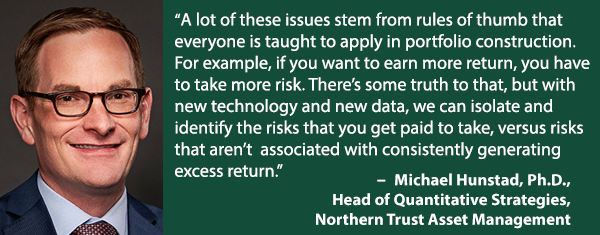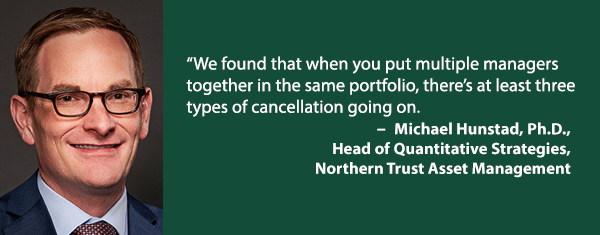Over the course of four years, Northern Trust Asset Management conducted a deep analysis of more than 200 institutional equity portfolios, which incorporated more than 1,000 investment strategies, and represented over $200 billion in AUM. The result is “The Risk Report,” which surfaces six common drivers of unexpected results in institutional portfolios. Some are the unintended result of following investing “rules of thumb,” and the picture that emerges from the report is that everything in a portfolio is interconnected – and incredibly complex and nuanced. To dive into the findings, II spoke with Michael Hunstad, Ph.D., head of quantitative strategies at the firm that conducted the study, and one of the keenest minds in the investment industry.
This is a remarkable undertaking that produced very actionable insights. What inspired it?
Michael Hunstad: About eight years ago, at the request of clients, we started performing deep dive analyses that enabled investors to view their portfolio through a different lens. Essentially, it was a portfolio diagnosis that identified all the various sources of risk. As we did hundreds of these over the years, it became obvious that there were systematic issues associated with many portfolios.
The Risk Report we just released is based on the last four years of conducting these analyses – and six key portfolio issues popped up over and over again.
Let’s talk about the key findings. You discovered that institutions had nearly twice as much uncompensated risk as compensated risk. Obviously, that’s not purposeful, so how does it happen?
Hunstad: A lot of these issues stem from rules of thumb that everyone is taught to apply in portfolio construction. For example, if you want to earn more return, you have to take more risk. There’s some truth to that, but with new technology and new data, we can isolate and identify the risks that you get paid to take, versus risks that aren’t associated with consistently generating excess return. The finding that investors are taking twice the amount of uncompensated risk as compensated risk is critically important. It highlights the need for precision in constructing your portfolio to accentuate compensated risks, and to eliminate those that are uncompensated.

What’s the first step toward greater precision in that process?
Hunstad: The first step is measuring what you have right now. With the diagnostic tool that we run we can break down the portfolio to reveal its sources of risk – whether that’s beta risk, credit risk, systematic risks, like sectors and countries, regions, style factors, and so on – and provide insight into the macroeconomic risks that are inherent to the portfolio. It’s like a health checkup to establish a starting point.
Another finding is that hidden risks caused unintended outcomes – and presumably that means not good outcomes. Does that mean the risk investors think they’re taking isn’t the risk they think they’re taking?
Hunstad: You’re spot on. Let’s say you’re a value investor. Right now, energy and financials are two sectors where there are a lot of value stocks. If you have value exposure to energy and financials, you might not realize that your exposure in energy has a lot of commodity price risks associated with it, and your exposure in financials has a lot of interest rate risks associated with it. You didn’t realize that your value portfolio was sensitive to oil price shocks, and you didn’t necessarily want that, but lo and behold you have that. That’s a hidden risk. By the way, it’s not always the case that energy and financials are value stocks. It can shift by sector, over time.
Another very relevant example: there’s a ton of volatility in equity markets, so a lot of investors are moving toward lower volatility portfolios. They want to ratchet down the risk, but in doing so they overweight sectors such as utilities and real estate, which are also very interest rate sensitive and are bond proxy sectors with embedded duration. You might think they’ve lowered the risk of their portfolio, but it turns out they actually amplified a lot of the macroeconomic volatility and that is transmitted into the portfolio. That’s the kind of hidden risk that can come back to bite investors, and it’s why we have to have precision in the construct of the portfolio.

You also found that underlying portfolio holdings cancel each other out – which hurts performance. Does that result from over-diversification?
Hunstad: It does, and that’s tied to another rule of thumb – that all diversification is good, and it’s better to have more diversification than less. Again, there’s some truth to that, but when we look through the data and the findings the reality is that there’s a very strong tendency to diversify away the risks that you actually want.
We found that when you put multiple managers together in the same portfolio, there’s at least three types of cancellation going on. The first type we’ll call factor cancellation. You have managers that are growth oriented, and you have managers that are value oriented – on opposite sides of the spectrum. As such, your value managers are very likely canceling out your growth exposure, and your growth managers are very likely canceling out your value exposure. At the extreme, and we found a few instances of this with portfolios that held both the Russell 1000® growth index and the Russell 1000 value index. Put those two together and you have precisely the Russell 1000 index at a higher fee. That’s a good example of cancellation. It’s like taking a chocolate bar and breaking it into two – one half is growth, one half is value, but in reality, it’s just one thing.
What are the other two types of cancellation?
Hunstad: We consider the second type to be systematic risk cancellation, which simply means that some of the portfolios’ underlying managers taking directly opposing positions such as being overweight a specific sector, region or country – and others may underweight. For example, some of them may overweight the U.S., others may underweight it and so forth, so that you have cancellation of those systematic exposures.
The third type of cancellation is probably the most obvious, but also terribly potent: we refer to it as “active share cancellation.” For example, Manager A is overweight Stock One, and Manager B is simultaneously underweight Stock One. Investors pay active managers to take risks, but we typically find that there’s so much cancellation going on within the end portfolio that you end up with benchmark-like performance – all of the good risk is cancelled out – but with a much higher fee. So, the performance is actually benchmark minus the fees.
How do investors react when you have conversations with them about all of this?
Hunstad: It’s a positive reaction. The vast majority of the asset owners who go through this exercise have a hunch that something like I’ve been describing is going on. So, it’s confirmation of something they probably knew in the back of their minds. The beauty of the six themes we’ve identified in the report is that they can all be solved for. While the methodology and tools used to conduct the portfolio analysis are quite complex, once we isolate the problem, it’s very easy to find the solution.
Learn more about the common drivers of unexpected results in your portfolio.
The information is not intended for distribution or use by any person in any jurisdiction where such distribution would be contrary to local law or regulation. Northern Trust and its affiliates may have positions in and may effect transactions in the markets, contracts and related investments different than described in this information. This information is obtained from sources believed to be reliable, and its accuracy and completeness are not guaranteed. Information does not constitute a recommendation of any investment strategy, is not intended as investment advice and does not take into account all the circumstances of each investor. Opinions and forecasts discussed are those of the author, do not necessarily reflect the views of Northern Trust and are subject to change without notice.
This report is provided for informational purposes only and is not intended to be, and should not be construed as, an offer, solicitation or recommendation with respect to any transaction and should not be treated as legal advice, investment advice or tax advice. Recipients should not rely upon this information as a substitute for obtaining specific legal or tax advice from their own professional legal or tax advisors. References to specific securities and their issuers are for illustrative purposes only and are not intended and should not be interpreted as recommendations to purchase or sell such securities. Indices and trademarks are the property of their respective owners. Information is subject to change based on market or other conditions.
Northern Trust Asset Management is composed of Northern Trust Investments, Inc. Northern Trust Global Investments Limited, Northern Trust Fund Managers (Ireland) Limited, Northern Trust Global Investments Japan, K.K, NT Global Advisors Inc. (NTGA), 50 South Capital Advisors, LLC and investment personnel of The Northern Trust Company of Hong Kong Limited, Belvedere Advisors LLC and The Northern Trust Company.
© 2020 Northern Trust Corporation. Head Office: 50 South La Salle Street, Chicago, Illinois 60603 U.S.A.





